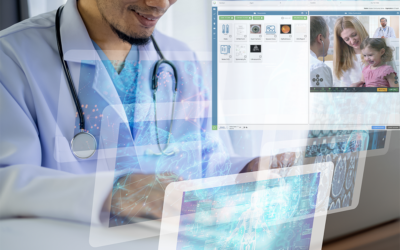Everyone has memories of going to the school nurse’s office when they were in elementary school, whether for a stomach ache or a nasty cut. Traditionally, while having these healthcare services available at schools has been essential for student safety, school nurses have been restricted in the services they’re able to provide due to personnel and technological limitations.
Telemedicine may be on board to change all that. Between providing nurses access to other healthcare professionals via remote conferencing and letting school healthcare staff monitor students remotely when necessary, school administrators are ready to give telemedicine an A .
Additional support for staff
It used to be that school nurses were effectively on their own when it came to treating students on campus. Thanks to telemedicine, those days are over. Emerging technologies such as video conferencing, remote diagnostic tools and electronic health record integration brings a new robust suite of options to school healthcare. The limited number of afflictions school staff can treat on-site leads to students being transported to hospitals and other care centers in emergency situations, which can drastically increase both the time and the cost associated with treatment in these cases.
With telemedicine, however, nurses have the opportunity to consult with healthcare providers and emergency medical staff to determine if such transport is necessary. Additionally, these doctors, nurses and clinicians can offer diagnostic input and treatment recommendations that can help school healthcare professionals treat students more effectively right there in the nurse’s office.
 Telemedicine can allow school medical staff to consult with other healthcare providers.
Telemedicine can allow school medical staff to consult with other healthcare providers.
Healthcare access for more children
Despite the leaps and bounds made in healthcare accessibility thanks to President Obama’s healthcare law passed in 2010, many kids in the U.S. still lack health insurance or access to basic services. In fact, a report from the Children’s Partnership indicated that there are 2.4 million children who live in officially recognized healthcare shortage areas just in the state of California alone. One indirect but greatly appreciated benefit of integrating telemedicine into schools is that these students now have a suite of healthcare options available in their school nurse’s office.
While school-based telemedicine isn’t intended to be a substitute for regular care at the hands of a physician, in some cases where students have no other access to such services, telemedicine can provide an invaluable benefit to children and their parents.
“Telemedicine in schools is simple and is designed to mimic a regular check-up.”
How does school-based telemedicine work?
Telemedicine in schools is simple and is designed to mimic a regular check-up or appointment that a child may have with his or her primary care physician. Although telemedicine can be used strictly for video conferencing consults, the true power of leveraging telemedicine in school-based applications is to be able to clinically treat a patient from afar. For example, a child goes to see the school nurse (or aide) as they normally would for any medical-related issue. The nurse can then sit the child in front of a telemedicine cart for a “patient check-up” from the doctor that mirrors the in-person experience. Instead of the physician sitting next to child, he or she assesses the child via screen while the nurse performs the clinical examination.
With a webcam, high-speed Internet connection, encounter management software and a few other pieces of equipment such as remote stethoscopes, school nurses can be equipped with the tools to help students with diagnostic concerns, symptom management and more. According to the Children’s Partnership, schools have successfully implemented telemedicine to help students manage such conditions as asthma, childhood obesity, oral health concerns, acute trauma and even mental health issues.
Telemedicine does not have to be expensive, extensive or exhaustive
Public health departments and schools across the country have a history of wrestling with budgets that may not be as large as administrators would like. With this in mind, adopting a telemedicine program may seem prohibitively expensive. In many cases a local community health center, hospital or physician’s practice will take on this ownership of setting up a telemedicine health center inside the school system. This allows schools and clinics to partner up and offer additional healthcare services to patients they might not be able to reach otherwise, and helps decrease hospital re-admission for issues that could have been easily managed through the health center at school.
Fortunately the cost of telemedicine equipment and technology can be significantly reduced with the use of software-based applications such as AGNES Interactive that do not require expensive video conferencing hardware. There are many school-based health centers that have already taken advantage of telemedicine technologies such as AMD’s Telemed ED, which is an all-in-one system that comes equipped with everything a school nurse needs to do a clinical examination.
To learn more about Telemed ED and how to get started with a school-based telemedicine program, visit www.amdtelemedicine.com.





